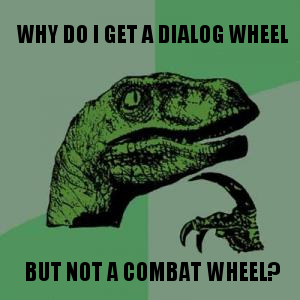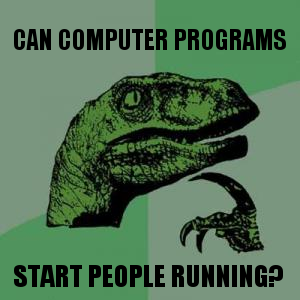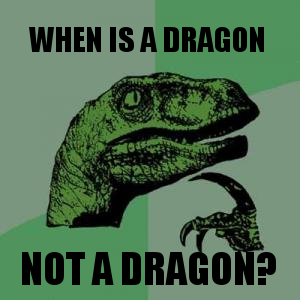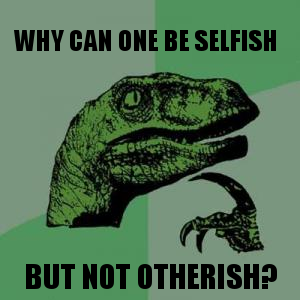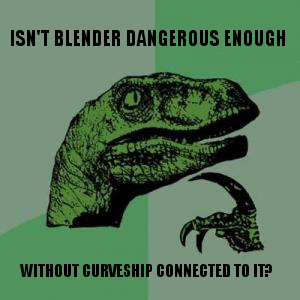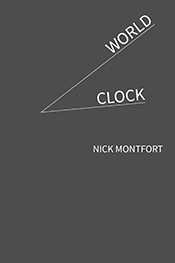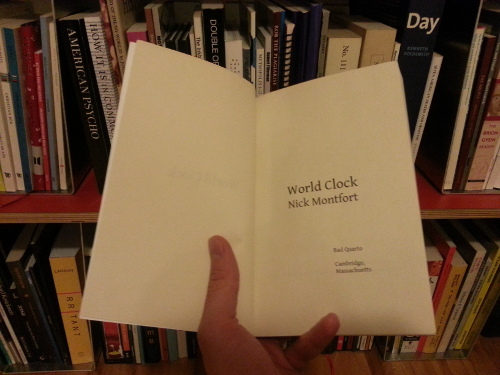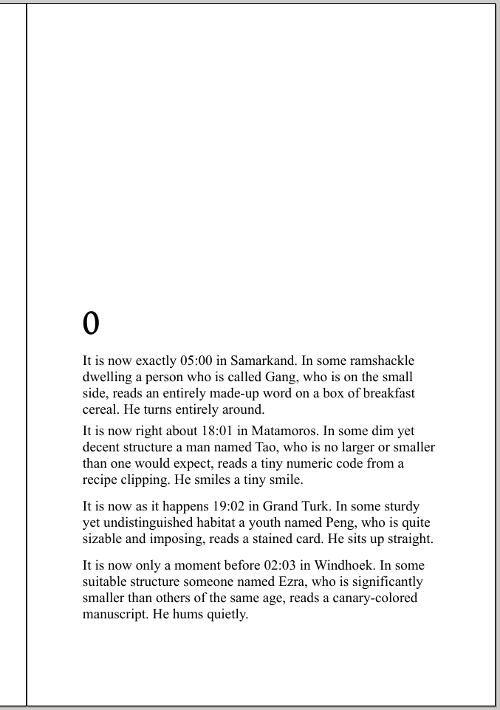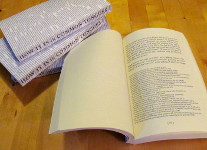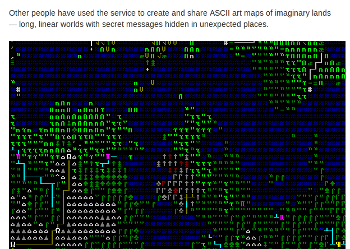(These pertain to Intelligent Narrative Technologies 7, and specifically today’s presentations. Perhaps, if you’re here, you will laugh. If you aren’t here, my regrets.)
Scott Rettberg in Purple Blurb this Monday
MIT, room 14E-310
Monday 4/28, 5:30pm
Free and open to the public, no reservation required
Scott Rettberg
 This Monday (2014-04-28) Purple Blurb is proud to host a screening and discussion of narrative video art work done in collaboration with Roderick Coover, including _The Last Volcano, Cats and Rats, Three Rails Live,_ and _Toxicity._ (The last two are combinatory pieces; _Three Rails Live_ is a collaboration between Coover, Rettberg, and Nick Montfort.) These pieces deal with personal and global catastrophes and are written across languages, with one of the voices in _Cats and Rats_ in (subtitled) Norwegian. They continue Rettberg’s work on novel-length electronic literature projects and his frequent collaboration with others.
This Monday (2014-04-28) Purple Blurb is proud to host a screening and discussion of narrative video art work done in collaboration with Roderick Coover, including _The Last Volcano, Cats and Rats, Three Rails Live,_ and _Toxicity._ (The last two are combinatory pieces; _Three Rails Live_ is a collaboration between Coover, Rettberg, and Nick Montfort.) These pieces deal with personal and global catastrophes and are written across languages, with one of the voices in _Cats and Rats_ in (subtitled) Norwegian. They continue Rettberg’s work on novel-length electronic literature projects and his frequent collaboration with others.
Scott Rettberg is Professor of Digital Culture in the department of Linguistic, Literary, and Aesthetic studies at the University of Bergen, Norway. Rettberg is the project leader of ELMCIP (Electronic Literature as a Model of Creativity and Innovation in Practice), a HERA-funded collaborative research project, and a founder of the Electronic Literature Organization. Rettberg is the author or coauthor of novel-length works of electronic literature, combinatory poetry, and films including _The Unknown, Kind of Blue, Implementation, Frequency, Three Rails Live,_ and _Toxicity._ His creative work has been exhibited online and at art venues including the Chemical Heritage Foundation Museum, Palazzo dell Arti Napoli, Beall Center, the Slought Foundation, and The Krannert Art Museum.
More about Purple Blurb …
Lance Olsen in Purple Blurb, Mon 5:30pm
“Lance Olsen is at the center of every discussion I have about the contemporary landscape of innovative and experimental writing.”
-Bookslut

Lance Olsen
April 7, 5:30pm
MIT’s Room 14E-310
Experimental writing & video
Including a reading from his recent book _[[ there. ]]_ and video from his _Theories of Forgetting_ project.
Lance Olsen is author of more than 20 books of and about innovative writing, including two appearing this spring: the novel based on Robert Smithson’s earthwork the _Spiral Jetty_, _Theories of Forgetting_ (accompanied by a short experimental film made by one of its characters), and _[[ there. ]]_, a trash-diary meditation on the confluence of travel, curiosity, and experimental writing practices. His short stories, essays, and reviews have appeared in hundreds of journals and anthologies. A Guggenheim, Berlin Prize, N.E.A. Fellowship, and Pushcart Prize recipient, as well as a Fulbright Scholar, he teaches experimental theory and practice at the University of Utah.
Read the Bookslut interview about Lance Olsen’s [[ there. ]].
More on the Purple Blurb series.
Purple Blurb takes place on MIT’s main campus in Building 14, the same building that is the home of the Hayden Library. 14E-310 in in the East Wing, third floor, across the courtyard from the library entrance (do not enter the library to get to 14E-310).
Purple Blurb is free and open to the public, no reservation required.
From Finnegans Wake as Read by Samuel L. Jackson
_Now by a commodious vicus of recirculation – go the fuck to sleep._
World Clock in Print & for Sale
My novel World Clock, generated by 165 lines of Python code that I wrote in a few hours on November 27, 2013, is now available in print.
>_World Clock_ tells of 1440 incidents that take place around the world at each minute of a day. The novel was inspired by Stanislaw Lem’s “One Human Minute” and Harry Mathews’s “The Chronogram for 1998.” It celebrates the industrial concept of time and certain types of vigorous banality which are shared by all people throughout the world.
The code has been online, along with a PDF of the book’s text, since late November. The Python program that generated this novel is available under a free software license. Anyone may make whatever use of it; generate your own novel with the unchanged code, if you like, or modify it to produce something different, for instance.
The book _World Clock_ is for sale to local and remote customers from my local independent bookstore, the Harvard Book Store. (No direct relationship to the university of the same name; they both happen to be located in Harvard Square.) The book is printed on the Espresso Book Machine in the store – to the amazement of onlookers. The apparatus has been dubbed “Paige M. Gutenborg.”
The 239-page paperback can be purchased for only $14.40, which is the low, low price of only one cent per minute.
Video of Nanowatt Online
A single-loading VIC-20 demo (3583 bytes) presented on November 30, 2013 at Récursion in Montréal. By Nick Montfort, Michael C. Martin, and Patsy Baudoin (nom de nom, mcmartin, baud 1). This video is of the demo running in the Trope Tank at MIT on December 3, 2013.
Tagged on YouTube as Commodore VIC-20, Samuel Beckett, Electronic Literature, Computer (Musical Instrument), and Demoscene. See also the fuller story about Nanowatt with links to executable code.
NaNoGenMo Wraps Up and Prints Out
There are some things I absolutely must mention at this point, to highlight certain of the many interesting outcomes from NaNoGenMo (National Novel Generation Month):
Alice’s Adventures in the Whale, one of two novels created by Leonard Richardson by computationally replacing all the dialog in one novel with the dialog in another:
>Alice was beginning to get very tired of sitting by her sister on the bank, and of having nothing to do: once or twice she had peeped into the book her sister was reading, but it had no pictures or conversations in it, “Can’t sell his head?–What sort of a bamboozingly story is this you are telling me?” thought Alice “Do you pretend to say, landlord, that this harpooneer is actually engaged this blessed Saturday night, or rather Sunday morning, in peddling his head around this town?”
…
>Presently she began again. “Ka-la! Koo-loo!” (she was rather glad there WAS no one listening, this time, as it didn’t sound at all the right word) “Stand up, Tashtego!–give it to him!” (and she tried to curtsey as she spoke–fancy CURTSEYING as you’re falling through the air! Do you think you could manage it?) “Stern all!”
…
>”My God! Mr. Chace, what is the matter?” said poor Alice, and her eyes filled with tears again as she went on, “we have been stove by a whale.” cried Alice, with a sudden burst of tears, “NARRATIVE OF THE SHIPWRECK OF THE WHALE SHIP ESSEX OF NANTUCKET, WHICH WAS ATTACKED AND FINALLY DESTROYED BY A LARGE SPERM WHALE IN THE PACIFIC OCEAN.”
…
>CHAPTER V. Advice from a Caterpillar
>
>The Caterpillar and Alice looked at each other for some time in silence: at last the Caterpillar took the hookah out of its mouth, and addressed her in a languid, sleepy voice.
>
>”I say, pull like god-dam,” said the Caterpillar.
>
>This was not an encouraging opening for a conversation. Alice replied, rather shyly, “There she slides, now! Hurrah for the white-ash breeze! Down with the Yarman! Sail over him!”
Leonard’s other submitted novel used Pride and Prejudice (and Through the Looking Glass). Along similar lines, you may be interested in seeing what Pride and Prejudice looks like without any dialog.
Early in the month, Zarf (Andrew Plotkin) submitted a generated novel that is entirely dialog: Redwreath and Goldstar Have Traveled to Deathsgate.
Ian Renton generated Doctor Who fan fiction using the technique of Bayseian poisoning, which is popular in spam generation. It’s only the only fanficlicious novel; see the generated Austenesque novels of jiko.
I was implicated in inspiring Nif, a palindromic 50,000-word+ novel, the second generated novel submitted (early in the month) by catseye. A remixed and extended version was done by Michael Paulukonis.
Don’t miss Aaron Reed’s Agressive Passive, which details conversation between six housemates about maintaining the cleanliness of their domicile.
And finally, my entry is World Clock, which briefly describes something happening, at some location around the world, at each minute of a day.
The overall “site” for NaNoGenMo, which was the fervent brainchild of Darius Kazemi, is, by the way, this humble GitHub repository.
Nanowatt
At Récursion (the Montréal demoparty), we (Nick Montfort, Michael C. Martin, and Patsy Baudoin) released Nanowatt, a single-loading VIC-20 demo.
You can download it and run it using a VIC-20 emulator (or, of course, an actual VIC-20). I run it in VICE on my Ubuntu system by typing “xvic nw” from the directory that contains the “nw” file. If it’s more convenient, you can also download a d64 disk image with Nanowatt on it and load “nw” from there.
It produces 8 KB of English text quoted exactly from Samuel Beckett’s second novel, Watt.
And it produces 8 KB of French text quoted exactly from the French translation of Samuel Beckett’s second novel, Watt.
And the entire demo (including two songs, sound system, code for decompression and display of text, and explanations and greetings at the end) is 3.5 KB: 3583 bytes.
When possible, I will upload a video of the demo running.
This rather esoteric demo was awarded 2nd place (out of 3 entries).
I also got 4th place (out of 5) for my one-line BASIC program that was done as a fast demo, based on today’s theme: “weaving.”
Demoscene.
UPDATE: You can run Nanowatt without leaving the comfort of your browser. First, copy this URL into your copy-and-paste buffer: << http://nickm.com/poems/nw >>. Then, go to the page for JS VIC-20. Select the “Storage” menu from the top and choose the option at the bottom of the list, “Carts/Programs,” and choose the top option, “Load Cart from URL.” Finally, paste in the URL that you copied and watch the demo run.
‘NOTHER UPDATE: Video of the demo running on a VIC-20 has been posted.
World Clock
This is my contribution to NaNoGenMo (National Novel Generation Month), written in about four hours on November 27. (Messing with the typesetting took a bit more time.)
Source code in Python. Requires pytz.
World Clock, the generated novel presented as a 246-page PDF.
National Novel Generation Month Begins
Read all about it! And sign up. It’s the brainchild (or brainbot) of Darius Kazemi.
The Tale of the MLA E-Lit Exhibit, Reading
Kathi Inman Berens storified some nice media elements relating to the 2013 electronic literature exhibit and reading at the MLA Convention.
Radical Books of 2012 (7/7)
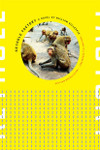
Keyhole Factory
William Gillespie
Soft Skull Press · 368 pages
William, congratulations to you – and Soft Skull Press – on the new, big publication of Keyhole Factory, which some might think is your first novel. Actually, your intensity of writing would humiliate Roberto Bolaño. You have at least eight books (some pseudonymous, some collaborative) available via your press Spineless Books, which publishes other people’s work as well. You share a quality with George Perec in that you are a graphophile, and you share another quality with him in that you are an incredible writer, imaginative on all levels, as you demonstrate in Keyhole Factory. It’s great that Jeff Clark designed the cover. I think I see why he used the picture of the monkeys. They’re voyeuristic subjects; we’re watching them as if through a keyhole. That one in the middle looks back, making us nervous. If they were people they’d be eating lunch or making love or watching TV or something, and we’d fixate on that. But they’re monkeys, so we just notice that one of them is watching us. You think?
Radical Books of 2012 (2/7)
How It Is in Common Tongues
Cited from the Commons of digitally inscribed writing by John Cayley & Daniel C. Howe
NLLF [Natural Language Liberation Front] · 296 pages
Some seek diamonds in the rough on the Web; others mine from this lode of language mud and darkness. This profound document was fashioned with snippets of pages, with the search engine, and with the novel first publised as Comment c’est – using all of them quite perversely. Samuel Beckett’s 1964 How It Is describes a person moving and not moving through the mud, alone, not alone, and then once more alone. Cayley and Howe, bending the service known as Google to their literary purposes, have located every phrase of the novel on Web pages where no reference to Beckett is made. For instance, the first words, “how it was I quote,” are found in a New York Times excerpt from Elie Wiesel’s And The Sea is Never Full. The phrase is provided, the URL is given in a footnote … and the same is done for every other phrase in How It Is. The result is an edition of Beckett’s book made of text that was literally found on the Web. The only thing funnier will be the Beckett Estate’s response.
Queerskins and The Silent History Are New Digital Novels
I discuss the history and context of electronic literature in this article about the new digital novel The Silent History. The article, by Eugenia Williamson, appears in Saturday’s print edition of the Boston Globe.
The Silent History certainly looks like a compelling project.
Another just-released digital novel which is also quite compelling, although it doesn’t have the same PR apparatus behind it, is Queerskins by Illya Szilak, designed by Cyril Tsiboulski. Although I’ve not read a great deal of this new novel yet, I’m impressed by its multimedia and literary engagement with a difficult aspect of recent American experience.
Queerskins explores the nature of love and justice through the story of a young gay physician from a rural Midwestern Catholic family who dies of AIDS at the start of the epidemic. Queerskins’ interface consists of layers of sound, text, and image that users can navigate at random or experience as a series of multimedia collages. Images of the mythic and the everyday, the sacred and the profane, from banal vacation footage to vintage burlesque, interact rhizomatically with text and audio monologues to subvert preconceived notions of gender, sexuality, and morality.
Queerskins can be read online for free, and it can be reading using free software; an iPad is not required. Although I’m a fan of location-based and other innovation and respect those working on all sorts of platforms, what I’d like for the future of literature is for it to be like this – fully accessible on even a public library computer and Internet-connected laptops throughout the world.
Shuffle Literature? Read ‘Em and Weep
Among several notable new articles in ebr (electronic book review), please find “Shuffle Literature and the Hand of Fate” by Zuzana Husárová and Nick Montfort:
Zuzana Husárová and Nick Montfort up the ante for experimental writing by examining the category of “shuffle literature.” What is shuffle literature? Simply put: books that are meant to be shuffled. Using formal reading of narrative and themes, but also a material reading of construction and production, Husárová and Montfort show that there are many writing practices and readerly strategies associated with this diverse category of literature.
A Thousand Twitters
News of a strange new social network, Monolyth, reaches us from December of this year and from Chris McDowall.
To sate the great appetites of the system, which will only publish messages at least 140,000 characters long (and will abbreviate longer ones), authors turn to unusual techniques.
One of these is generating massive texts using modified versions of Taroko Gorge, one of which is included in the blog post.
Islands of (Text) Adventure
In the “Michelangelo” room of the Portofino Bay hotel, at Ascendio (the latest and last in a long series of Harry Potter fan conferences), just down the lagoon from The Islands of Adventure and the Harry Potter area of that theme park, Flourish Klink presented her interactive fiction, “Muggle Studies.”
(In Michelangelo the women come and go, talking of rooms…)
We had a reading/playing of the game, to start, in the People’s Republic of Interactive Fiction public reading style. It worked well; another option would have been to “demo” the game using the successful format we tried out at the New School, Penn, and some Purple Blurb IF readings. The audience was game to try commands, though, and a volunteer read the game’s text aloud.
Then, Flourish provided some context, describing a bit about IF and Inform 7.
Given the vigorousness of fandom and the way interactive fiction production continues apace, it’s particularly good to see a demonstration of and call for more crossover work.


